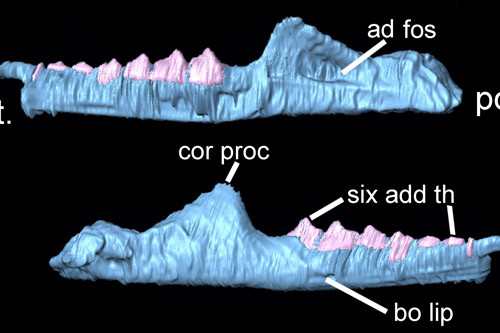205-million-year-old fossil identified as new species of tiny reptile that lived alongside dinosaurs
The fossil revealed that the ancient reptile lived alongside a small dinosaur and a crocodile-like creature.

A 205-million-year-old fossil has been identified as a new species of tiny reptile, which according to palaeontologists, lived alongside a small dinosaur and a crocodile-like creature. The fossil, which was found in rocks in a quarry near Cardiff, has been named Clevosaurus cambric.
The fossil was identified by Emily Keeble, an undergraduate at University of Bristol's School of Earth Sciences, as part of her final year project for her palaeontology degree. The fossil of the prehistoric reptile was first collected in the 1950's from the Pant-y-ffynnon Quarry in South Wales and was identified as a new species of the 'Gloucester lizard' Clevosaurus.
"The new species, Clevosaurus cambrica lived side-by-side with a small dinosaur, Pantydraco, and an early crocodile-like animal, Terrestrisuchus. We compared it with other examples of Clevosaurus from locations around Bristol and South Gloucestershire, but our new beast is quite different in the arrangement of its teeth," Keeble said in a statement.
During the Late Triassic Period, the hills of South Wales formed an island which became home to small dinosaurs as well as relatives of the Tuatara, a reptile endemic to New Zealand. The limestone quarries in the region contain numerous caves or fissures that hold the bones of numerous tiny reptile species, which provide us with a glimpse of the kind of creatures that once scurried about at the feet dinosaurs.
"We were lucky to find quite a lot of the skeleton and Emily was able to scan the blocks and make 3D reconstructions of the skull, neck, shoulder and arm region," said Mike Benton, Keeble's supervisor who is professor of vertebrate palaeontology and head of school of biological sciences.
"The teeth of Clevosaurus cambric were likely adapted to dice pieces of flesh, so we interpret this little critter as a predator, feeding on insects and other small animals," said Dr David Whiteside, a co-supervisor. "The dinosaurs, crocodiles, and lizards were isolated to some extent on their islands, and perhaps smaller ones were better at surviving in the changed ecologies of the islands."






















